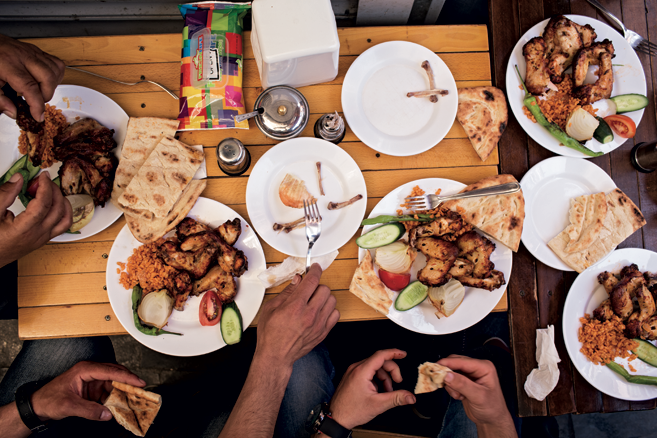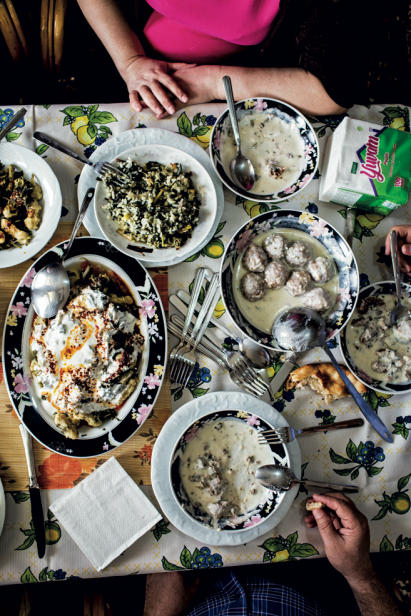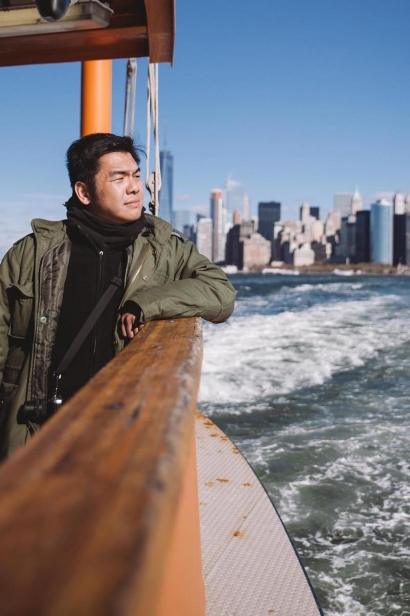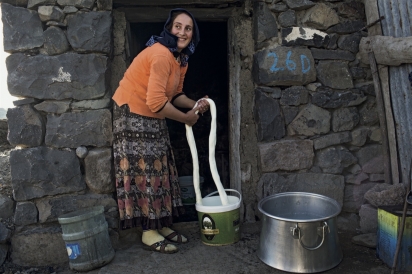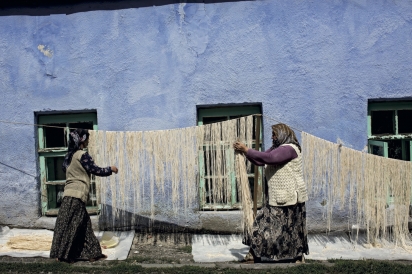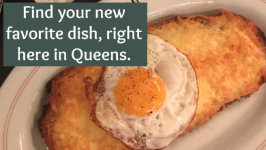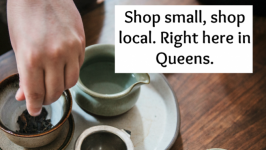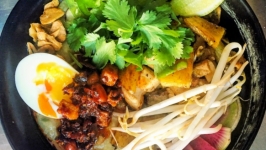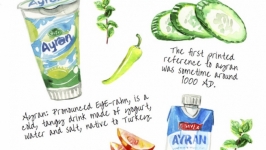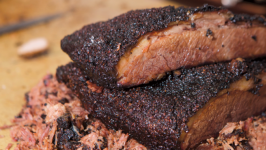Exploring the Cuisines of Turkey along the Sidewalks of Sunnyside
“What do you eat at home?”
That was the question that changed the course of writing Istanbul and Beyond: Exploring the Diverse Cuisines of Turkey, the new cookbook by writer Robyn Eckhardt and photographer David Hagerman, the wife-and-husband team of travel and food journalists whose work has been published in the New York Times and Travel + Leisure, and whose website, EatingAsia, was named Best Culinary Travel Blog by the readers of Saveur.
I joined the two of them in Queens’ own Turkish enclave of Sunnyside, where we enjoyed lunch at the Turkish Grill on Queens Boulevard. Eckhardt and Hagerman, who have traveled regularly to Turkey since 1998 and spent 16 months there researching Istanbul and Beyond, were impressed by the authenticity of the dishes we ordered: cacik, ezme, imam bayildi, kofte kebab and etli lahana. But Turkish Grill’s menu, like that of many Turkish restaurants, is dominated by the cuisine of Istanbul rather than the regional dishes that Eckhardt and Hagerman feature in their book.
Between the meze and the mains, Eckhardt said, “The food that we get in most Turkish restaurants in the U.S. is from Istanbul, and a lot of Istanbul cuisine is the cuisine of the Ottoman Palace, things like the imam bayildi we just ate, böreks with flaky dough, lokum, a lot of the sweets. Fancy food.”
Etli lahana (cabbage stuffed with rice and ground meat) is a dish that might well have been served in Ottoman palaces, but Turkish Grill’s use of sumac in the sauce suggested to Eckhardt influence from well to the east of Istanbul. She asked our server where the chef is from. As it turned out, the chef—like so many working in kitchens to feed New Yorkers—is from Mexico, and execution of his Turkish cooking is all the more impressive for it. But the owner of Turkish Grill is from Sivas, in central Anatolia, confirming Eckhardt’s hunch.
Turkish Americans can trace their roots to all over Turkey, but the menus of the restaurants they open don’t reflect that. Eckhardt put it this way: “Once you get beyond Istanbul, palace cuisine does not really play a part in the way people eat, which is determined by the seasons and the landscape and what grows around them. And it’s home food. Once you get beyond cities—and eastern Turkey is still largely agricultural—people don’t eat baklava very much. You have to go from your village into a city to buy baklava. People are not eating baklava, they’re not eating kebabs. Kebab is restaurant food.” “It’s funny. We were with friends in Hatay province, and they invited us over for a dinner of kebabs. The husband went to the butcher, and then he went to one of these places where you grill your own kebabs, and you take them home. Because people don’t make kebabs at home.”
Eckhardt includes the recipe for that kebab in Istanbul and Beyond, so she hopes her readers will try, even if it’s atypical for Turks to do so. Another of her hopes is that Istanbul and Beyond will broaden readers’ ideas about the people who live in Turkey and the food that they eat. Most of the book’s on-location photos were taken by Hagerman in real people’s homes, which aren’t usually decorated like Ottoman palaces. When the time came to style a studio shoot, he eschewed colorful tiles and other icons of what Eckhardt called “theme park Turkey” because it wouldn’t have been visually consistent with the photographs he took the in the real Turkey. Istanbul and Beyond includes a recipe for eski peynirli hangel, which Eckhardt identifies as a Kurdish dish of flat noodles with cheese and melted butter. Eckhardt knows a Turkish restaurant in New Jersey where the chef is Kurdish and for whom eski peynirli hangel is a Proustian reminder of childhood, yet it does not appear on his menu, even though noodles, butter and cheese are all things the American palate loves, and loves even better together. A food can be off-putting when it is too strange to one’s palate, but where one expects the exotic, a food can fail to entice if it doesn’t meet those expectations—in this case what the food of Turkey is supposed to be like—even when that food is truly authentic.
You may have noticed that I have begun using constructions like “the food of Turkey” instead of “Turkish food” and “people who live in Turkey” instead of “Turkish people” or “Turks.” This is because, no matter how carefully its author tiptoes around politics, a book about the food eaten by the people far from a country’s political and economic centers cannot entirely avoid being about that country’s marginalized peoples, whose distinct identities—and sometimes lives—those in power have tried to erase. Eckhardt asked the Kurdish cookbook author Ali Geyik, “‘How do you say this is a Kurdish dish and that’s a Turkish dish?’ And he said, ‘You know, I’m not writing about politics. I’m writing about food. I just want to document the food,’ And some might say that’s a cop-out, but I’m not writing this book to make a political statement.”
“When a dish came from an area where the population was mostly Kurdish, I would call it a Kurdish dish in the book. Now, it may well have Armenian roots, Turks may make it too in a slightly different way. I had this idea in the beginning that I would tell the story of every dish and trace it back; that’s impossible in a place like Turkey.” As an example, Eckhardt cited paskalya çörek, a rich mahleb-scented bread traditionally eaten at Easter by the Ottoman Empire’s historic Christian communities of Armenians and Greeks. “We watched them being made in a bakery in Diyarbakir, which is a Kurdish city. The baker told us, ‘Armenians were the bakers here, and they taught us how to make them.’ So if that recipe hadn’t been cut, I probably would have called it an Armenian pastry. But it’s now made by Kurds in a Kurdish city. Without being super political, I have to acknowledge that the Armenian genocide happened, but I’m not here to draw lines.” Eckhardt shared with me the observation that, in the United States, Armenian markets are a great place to source ingredients for Turkish cooking. The fact that Queens is home to sizable communities of both Turkish Americans and Armenian Americans may not be coincidental. While cultural and culinary affinities can never erase the pain of communities in conflict, in a new country they can make it possible to establish a modus vivendi.
At a time when their former compatriots were at war with each other, refugees from the former Yugoslavia’s Serbian, Croatian and Bosnian communities—once subjects of the Ottoman Empire—were building new lives in Astoria. When Chinese immigrants followed Taiwanese immigrants to Flushing, it transformed what until the 1990s had been Little Taipei into New York’s second Chinatown today. In Jackson Heights, Indian Americans and Pakistani Americans belong to what community leader Agha Saleh has called “a living United Nations in the street.”
After we finished our meal with cups of strong tea and left Turkish Grill, we passed by the Sunny Fish Market, the mom-and-pop fishmonger owned by a literal Korean mom and pop. Eckhardt pointed out a sign in the window advertising hamsi, the currently in-season Black Sea anchovies much beloved in Turkey. Hamsi are a perfect example of the seasonal food that the people of Turkey really do eat. If we’re lucky, we’ll see them on the menus of more Turkish restaurants here soon.
Istanbul and Beyond: Exploring the Diverse Cuisines of Turkey | @istanbulandbeyond
Robyn Eckhardt | @byneckhardt3317
David Hagerman | @davehagerman
EatingAsia | @eatingasia
Turkish Grill
Sunny Fish Market


